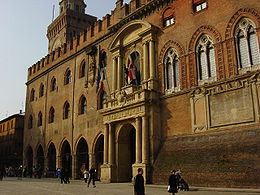
Palazzo d'Accursio
Encyclopedia

Palace
A palace is a grand residence, especially a royal residence or the home of a head of state or some other high-ranking dignitary, such as a bishop or archbishop. The word itself is derived from the Latin name Palātium, for Palatine Hill, one of the seven hills in Rome. In many parts of Europe, the...
in Bologna
Bologna
Bologna is the capital city of Emilia-Romagna, in the Po Valley of Northern Italy. The city lies between the Po River and the Apennine Mountains, more specifically, between the Reno River and the Savena River. Bologna is a lively and cosmopolitan Italian college city, with spectacular history,...
, Italy
Italy
Italy , officially the Italian Republic languages]] under the European Charter for Regional or Minority Languages. In each of these, Italy's official name is as follows:;;;;;;;;), is a unitary parliamentary republic in South-Central Europe. To the north it borders France, Switzerland, Austria and...
. It is located on the Piazza Maggiore and had been the city's Town Hall until 11 November 2008.
Palazzo d'Accursio is home to the Civic Art Collection, with paintings from the Middle Ages to the 19th century. It also houses the Museo Morandi, with the works by Giorgio Morandi
Giorgio Morandi
Giorgio Morandi was an Italian painter and printmaker who specialized in still life. His paintings are noted for their tonal subtlety in depicting apparently simple subjects, which were limited mainly to vases, bottles, bowls, flowers, and landscapes.-Biography:Giorgio Morandi was born in Bologna...
donated to the comune
Comune
In Italy, the comune is the basic administrative division, and may be properly approximated in casual speech by the English word township or municipality.-Importance and function:...
by his family.
History
Palazzo d'Accursio includes a complex of edifices which were united during centuries, but originally it was the residence of the jurist Accursius. In 1336 it became the seat of the Anziani ("Elder"), the highest magistrates of the commune, and then seat of the government. In the 15th century it was restored by Fioravante Fioravanti, who added, among the other feature, the Clock Tower (Torre d'Accursio). Other restorations date to the 16th century, just after the fall of the seigniory of the BentivoglioBentivoglio
Bentivoglio was an Italian family of princely rank, long supreme in Bologna and responsible for giving the city its political autonomy during the Renaissance.-History:...
family in Bologna.
Art and architecture
The façade features a portcullisPortcullis
A portcullis is a latticed grille made of wood, metal, fibreglass or a combination of the three. Portcullises fortified the entrances to many medieval castles, acting as a last line of defence during time of attack or siege...
and a Madonna with Child, a terracotta by Niccolò dell'Arca (1478) in the upper section. Over the portal is a large bronze statue of the Bolognese Pope Gregory XIII
Pope Gregory XIII
Pope Gregory XIII , born Ugo Boncompagni, was Pope from 1572 to 1585. He is best known for commissioning and being the namesake for the Gregorian calendar, which remains the internationally-accepted civil calendar to this date.-Youth:He was born the son of Cristoforo Boncompagni and wife Angela...
(1580). A bronze statue of Pope Boniface VIII
Pope Boniface VIII
Pope Boniface VIII , born Benedetto Gaetani, was Pope of the Catholic Church from 1294 to 1303. Today, Boniface VIII is probably best remembered for his feuds with Dante, who placed him in the Eighth circle of Hell in his Divina Commedia, among the Simonists.- Biography :Gaetani was born in 1235 in...
is now in Medieval Museum.
The Hall of the Communal Council, on the first floor, contains a frescoed gallery of the Bolognese Senators by Angelo Michele Colonna and Gioacchino Pizzoli (1675–1677). From the same period is the Vidoniana Gallery (1665) with an exhibition of paintings, furniture.
The Farnese Hall, on the second floor, was rebuilt in 1665 by Cardinal Girolamo Farnese: it was previously known as "Royal Hall", and here was crowned Charles V
Charles V, Holy Roman Emperor
Charles V was ruler of the Holy Roman Empire from 1519 and, as Charles I, of the Spanish Empire from 1516 until his voluntary retirement and abdication in favor of his younger brother Ferdinand I and his son Philip II in 1556.As...
in 1530. It has fresco decoration by pupils of Francesco Albani
Francesco Albani
Francesco Albani or Albano was an Italian Baroque painter.-Early years in Bologna:Born 1578 in Bologna, his father was a silk merchant who intended to instruct his son in the same trade; but by age twelve, Albani became an apprentice under the competent mannerist painter Denis Calvaert, where he...
. The Chapel has frescoes by Prospero Fontana
Prospero Fontana
Prospero Fontana was an Italian painter of the late Renaissance.-Biography:Fontana was born in Bologna, and became a pupil of Innocenzo da Imola. He afterwards worked for Perin del Vaga in the Palazzo Doria in Genoa. Towards 1550, it is reported that Michelangelo introduced him to Pope Julius III...
(1562). The Hall is decorated with stories of the city from the Middle Ages to the 17th century.

